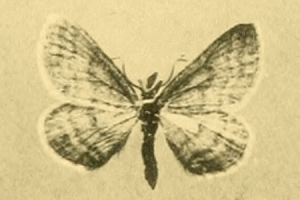
The cream wave is a moth of the family Geometridae. The species was first described by Adrian Hardy Haworth in 1809. It is found in forest and woodland regions, feeding on grasses and small plants such as dandelion.

Scopula immorata, the Lewes wave, is a moth of the family Geometridae. It is found throughout Europe and the Near East.

Sterrhinae is a large subfamily of geometer moths with some 3,000 described species, with more than half belonging to the taxonomically difficult, very diverse genera, Idaea and Scopula. This subfamily was described by Edward Meyrick in 1892. They are the most diverse in the tropics with the number of species decreasing with increasing latitude and elevation.

Scopulini is a tribe of the geometer moth family (Geometridae), with about 900 species in seven genera. The tribe was described by Philogène Auguste Joseph Duponchel in 1845.
Scopula asthena is a moth of the family Geometridae. It was described by Hiroshi Inoue in 1943. It is found in Japan, north-eastern China and south-eastern Russia.
Scopula pudicaria is a moth of the family Geometridae. It is found from north-eastern China to south-eastern Russia, Korea and Japan.
Scopula subpunctaria is a moth of the family Geometridae. It is found from northern and north-eastern China to the southern Palearctic realm.
Scopula prouti is a moth of the family Geometridae. It is found from north-eastern China to Korea, Japan and south-eastern Russia.
Scopula indicataria is a moth of the family Geometridae. It is found in China, Korea, Japan and Russia.
Scopula bifalsaria is a moth of the family Geometridae. It was described by Prout in 1913. It is endemic to China.

Scopula cajanderi is a moth of the family Geometridae. It has a Holarctic, distribution, which includes Russia, Alaska and Yukon.
Scopula impersonata is a moth of the family Geometridae. It is found in China, the Russian Far East, Taiwan and Japan.
Scopula kuldschaensis is a moth of the family Geometridae. It was described by Sergei Alphéraky in 1883. It is found in China, Kyrghyzstan and Kazakhstan.

Scopula luridata is a moth of the family Geometridae. It is found in southern Europe, Asia Minor, China, Pakistan, India, Egypt, Somalia, Yemen, Oman and Japan.
Scopula modicaria is a moth of the family Geometridae. It was described by John Henry Leech in 1897. It is found in China, the Russian Far East, Korea and Japan.
Scopula mustangensis is a moth of the family Geometridae. It is found in the Palaearctic region.
Scopula praecanata is a moth of the family Geometridae. It is found in Tibet and central China (Sichuan).
Scopula superior is a moth of the family Geometridae. It was described by Arthur Gardiner Butler in 1878. It is found in Japan, the Russian Far East and China.
Scopula szechuanensis is a moth of the family Geometridae. It is found in central China (Sichuan).
Scopula vojnitsi is a moth of the family Geometridae. It is found in the Russian Far East.





